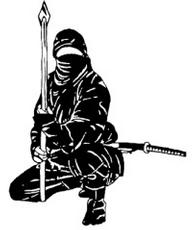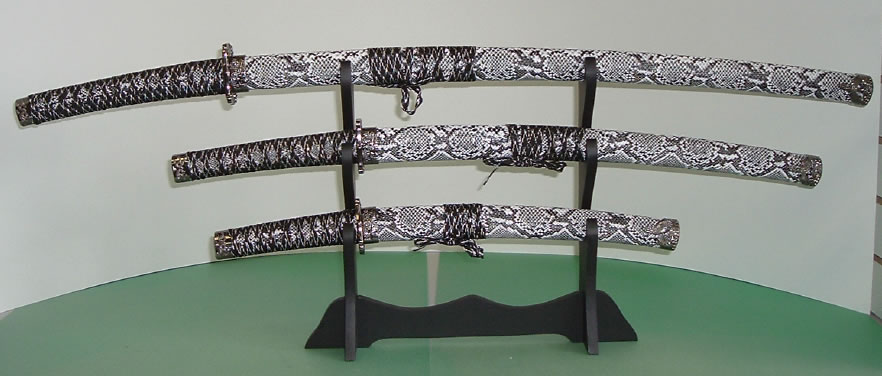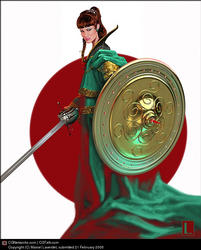Ninja Page
Here we'll explore different families
History of the Ninja and Ninjutsu
Iga and Koga Ninja
The Sengoku era marks a century of warfare in Japan, during the latter half of which the powerful daimyo Oda Nobunaga, Toyotomi Hideyoshi, and Tokugawa Ieyasu struggled for dominance, sometimes allied together, sometimes dramatically opposed, until at last Tokugawa Ieyasu was named Shogun in 1603, following his decisive victory at the Battle of Sekigahara, and Japan was united once again. During this time, documented ninja activity was at its peak. Ninja raids, attempted assassinations, reconnaisance missions, and other military operations were recorded in semi-historical documents such as the Hodo Godai-ki, a chronicle of the Hojo clan who once ruled Japan as regents to the shogun, the Shinchoko-ki, a biography of Oda Nobunaga, and the Iran-ki, the chronicle of Iga province. These references, when taken as a whole, reveal exactly what role the ninja played in warfare of the time.
Siege Warfare: This is by far the most often referenced skill of the ninja. The ability to enter into a castle by means of stealth, and launch a suprise attack on the inhabitants, causing confusion within while the main army storms the castle from without. Typically the ninja party would scale the walls of a castle under the cover of night, then start lighting everything in sight on fire. They would not wear black, but rather, wear the costume of the castle defenders, making it difficult to tell friend from foe, and so make it seem like there is a rebellion within the ranks. Once chaos reigns inside the castle, the army lays siege on its walls from without. If there was any special skill, then, that these ninjas were famous for, this was it. These ninjas were also able to perform valuable services if they were part of the force under siege in a castle. The ninja could sneak out of the castle at night, and steal the banner of the opposing army, and hang it on the battlements in the morning to demoralize the attackers. One source tells of the ninja going out nearly every night from a castle to frighten and harass the attacking army, without doing any physical damage -- however, the troops had to always be on the alert, and being unable to ever get a good night's sleep, the soldiers constantly on edge waiting for an attack all night, they were ineffective when the time came to launch an assault on the castle.
Scouts: Ninjas were often employed to assay the relative strength of the enemy. By one account, a ninja would lay in the tall grass just outside an enemy encampment and remain there until dawn before returning to report. In most cases, however, the scout simply goes on horseback, and is indistinguishable from scouts used in warfare anywhere in the world.
Assassins: This is what the Ninja is known for now. Even in the seventeenth century, the Daimyo feared assassination attempts by ninjas. All of the major generals seemed to have an assassin make an attempt on their life at some point or another. Of course, not all of these attempts are by ninjas, and the most well-known assassination, of Oda Nobunaga, was carried out by one of his generals, and not a ninja at all. In fact, nowhere have a found a single documented successful assassination carried out by a ninja. They were feared throughout Japan for the possibility, but it seems that possibility never became reality. Perhaps it's just like murder today -- everyone fears being killed by some stranger who randomly targets them, but in fact most people are killed by someone they know. The ninja really did try to kill people, though, they just weren't very successful at it. One tactic was to lie down on a battlefield, and when your mark rides through, looking at all the dead bodies, the ninja suddenly springs up and attacks. Nobunaga had some close calls before he met his fate, once being shot twice in the chest, the bullets being stopped by his armor. Later, perhaps learning from the previous attempt, Nobunaga is suprised by three cannon weilding ninjas who try to take him out with a bang. They miss, but kill seven of his retainers. Most ninja assassins were hired by rival daimyo to kill their opponent, without much success. It is this element of ninja skill which has been most over emphasized in our modern understanding of ninja warriors.
In many, but not all, of these accounts the ninjas in question originated from Iga or Koga province, now modern day Mie Province. This is considered the ancestral homeland of the ninja arts, and it does indeed seem to be the main area of ninja activity. Oda Nobunaga finally decided they were too dangerous and crushed Iga in a punitive expedition in 1581. Legend has it that surviving ninja dispersed to all parts of Japan after their defeat. Wherever they went, their usefulness was soon at an end. But where Oda Nobunaga looked at the ninja and only saw a threat, Tokugawa Ieyasu saw an opportunity, and soon he had a group of Koga ninja in his employ. They participated in the battle of Sekigahara, though without particularly distinguishing themselves. They worked for Tokugawa again in 1614-15, during the campaigns against the last Toyotomi heir, and one last time in 1638 against the Christian daimyo of Kyushu in the Shimabara Rebellion, in both cases operating in their traditional role as masters of seige warfare.
After the Shimabara Rebellion, there was peace at last. And lots of it -- over a hundred years worth. What's a ninja to do? Well, start a martial arts school, publish some weapon guides, and sit back and let the storytellers take over.
Ninja Myths and Legends
During the relative quiet time of the Edo period, under the rule of the Tokugawa Shogunate, the arts flourished. Stories, woodblock prints, and plays all told dramatic stories from the past. In these tales, the ninja became semi-mythical beings, whose ability to hide, stay silent, to siege castles, and to kill, grew to superhuman heights, and so the only explanation for their powers became sorcery. In one play a ninja is able to turn himself into a rat. Stories tell of another ninja who knows 'Toad Magic,' and rides on the back of a giant toad. In another tale, a ninja meets a sorcerer on the road, and when the ninja cuts the sorcerer open, and his intestines continue to attack the ninja, the ninja begs him to teach him the magic arts. In the face of such powers as these, the ability to fly or turn invisible seems commonplace.
Part of the mystical aura which surrounds the ninja may be due to their longstanding association with monks, especially the yamabushi, who would take long, mountain pilgrimages in the belief that such hardship combined with worship and fasting would reveal their religion to them, and at the same time be granted powers beyond that of ordinary humans. Iga and Koga provinces, being very mountainous, were both destinations for yamabushi. Add to this the rumours that ninjas often disguised themselves as wandering monks for purposes of concealment on intelligence missions, and it is easy to see how the magical powers ascribed to one can so easy be passed to the other.
As the legend of the ninja grew, so to did the amount of historic figures that were newly assigned ninja status. Any samurai who had an unaccounted for period of wandering in the mountains became a possible candidate: the warrior Yagyu Jubei, who served the Tokugawa but then took an unaccounted for ten year leave of absence, is a prime example. Hundreds of tales have been written about those unknown years and the events surrounding it, so much so that it is generally not questioned that Jubei, and in fact the entire Yagyu clan, were ninjas. And it could be true. Much less likely is the claim that Minamoto Yoshitsune, brother of the twelfth century shogun Yoritomo, was a ninja. Yoshitsune was forced to flee from his brother, who was trying to consolidate his power and make sure there would be no other claimants to the title of shogun. Yoshitsune has to disguise himself as a yamabushi to escape. But despite this ninja-like disguise, it would be several hundred years before ninjas really appeared in the historic record. But that doesn't stop ninja believers, who even go so far to claim that he founded a school of ninja arts, the Yoshitsune-Ryu.
In addition to the ninjas abilities in maritial arts and magic, one other power remains to be mentioned -- which is, they were legendary in the sack. As far back as the late eighteenth century, erotic art was being printed of ninja antics in the sack. Usually, the images were ones of violent entry and rape. The ninja, using his strength, his ability to gain entry to any place, would tie up or slay men and rape women at their pleasure. Japanese Ninja literature and cinema still contain a powerful element of the erotic. At first it seems odd, but consider the romance novels on the shelves of any bookstore in America -- hundreds of them feature rough and violent pirates and scoundrels, who rape the heroine, then ultimately fall in love with her in the romantic end. Swap that hairy-chested pirate with a black garbed ninja, and it's essentially the same story.
With all of these stories of the ninja being written, it was only a matter of time before they appeared on the Kabuki theater stage. And then, the actors had a dilemma -- how does one portray a ninja? And more importantly, what kind of costume should be used? Sometimes, they wore garb not dissimilar to any other samurai when playing a ninja on stage. But the ninjas reputation as masters of stealth and invisibility suggested a costume to the actors. Because there already were people on stage, in many performances (especially of the Bunraku or puppet theater), who were supposed to be invisible. They were the kurogo, or stage-hands. The stage-hands, to indicate to the audience that they were not meant to be seen and should be ignored, wore black from top to bottom. And here, at last, we have the famous ninja uniform -- those black pajamas that seem to provide little protection from weapons, little cover in pitch darkness, and foolishly advertise to the entire world who you are. It makes little sense for an outfit such as this to be used in the real world, but in the conventions of Kabuki theater, it was the perfect costume. And to this day, every ninja movie, no matter how authentic they attempt to be, includes the Kabuki stage-hand's costume as an unquestioned and vital part of ninja outerwear.
And so, during the Edo period, the ninja moved from the battlefield into the imagination, and have remained there ever since. While popular plays were presented to lay audiences of ninja exploits, those who believed they carried on the tradition of the ninja continued to practice their skills in various schools throughout the country. Many of them kept secret books which showed weaponry, medicines, and food recipies. As the long peace wore on, however, the need to keep these books secret became less and less, and eventually, many of them were published. It is these guides which have been used ever since as reference for the many weapons and other equipment used by the ninja.
Ninja Weaponry
Much of the mystique of the ninja lies in their arsenal of weaponry. Books published as long ago as 1676 illustrate many of the ninja weapons and techniques that were in use. The main weapons used by the ninja were the same weapons employed by samurai: the sword, the small sword, the bow and arrow. Other weapons, however, seem to have been unique to the ninja art:
 Clawed Weapons: There are two principal kinds: the neko-te or "cat's claws," and the shuko or "tiger's claws" (image right). The neko-te consists of sharp pieces of metal extending from the end of each finger, like the claws of a cat. This is supposedly a defensive weapon, used mainly by female ninjas. The shuko, on the other hand, has many applications. In addition to use in combat, they can also be used to assist in scaling walls and climbing trees. A matching pair can go on the feet.
Clawed Weapons: There are two principal kinds: the neko-te or "cat's claws," and the shuko or "tiger's claws" (image right). The neko-te consists of sharp pieces of metal extending from the end of each finger, like the claws of a cat. This is supposedly a defensive weapon, used mainly by female ninjas. The shuko, on the other hand, has many applications. In addition to use in combat, they can also be used to assist in scaling walls and climbing trees. A matching pair can go on the feet.
Sickle Weapons: The short handled sickle, or kama was a weapon that could be put to good use by ninja operatives. Since owning a weapon was banned to all but samurai, a ninja walking around with a utility belt full of swords and shuriken may stick out a bit. But the kama was a common farming tool, and a ninja carrying such a weapon would not call attention to himself. It can also be attached to a chain and becomes a much more complicated and dangerous weapon then, with greater range and utility.
 Shuriken: No discussion of the ninja is complete without mentioning the famous shuriken, or "throwing stars." There were many different styles of the weapon, but all of them would still look pretty nice on top of a Christmas tree.
Shuriken: No discussion of the ninja is complete without mentioning the famous shuriken, or "throwing stars." There were many different styles of the weapon, but all of them would still look pretty nice on top of a Christmas tree.
Invisibility Weapons: The ability to disappear or become invisible is one of the legendary traits of the ninja. To aid in this ability there was developed metsubushi, or "sight removing" techniques. A powder concoction would be created, the recipie of which differed from clan to clan, ninja to ninja, but usually included a variety of eye irritants (like our modern day pepper spray), and placed into an egg shell or nut shell for quick use. Combined with small explosives, the shock and suprise and itchy, running eyes should have been enough to allow a ninja to make his escape.
 Mudras: Part of the mystic side of the ninja arts is the forming of various hand signals called "Mudras." These Mudras are now a core component of the spiritual ninja's training, and can be seen in many films. In ninja legends and myths, these hand signals would usually be made to perform magic. However, these hand signs have very little connection to the ninja. Probably they became part of ninja mythology as part of their association with the yamabushi, the mountain pilgrim monks.
Mudras: Part of the mystic side of the ninja arts is the forming of various hand signals called "Mudras." These Mudras are now a core component of the spiritual ninja's training, and can be seen in many films. In ninja legends and myths, these hand signals would usually be made to perform magic. However, these hand signs have very little connection to the ninja. Probably they became part of ninja mythology as part of their association with the yamabushi, the mountain pilgrim monks.
There is only One Head Instructor.



